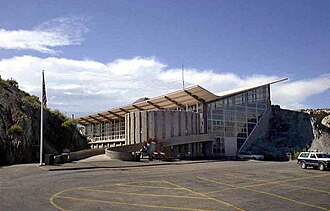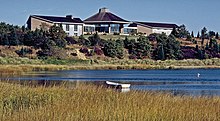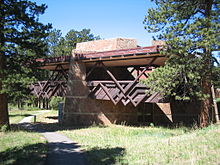|
Mission 66
 Mission 66 was a United States National Park Service ten-year program that was intended to dramatically expand Park Service visitor services by 1966, in time for the 50th anniversary of the establishment of the Park Service. When the National Park Service was created in 1916, long-distance travel in North America was typically accomplished by train. There was no national road system, and airline travel was in its infancy. Railroads were closely involved in the development of visitor services at such parks as Grand Canyon National Park, Glacier National Park and Yellowstone National Park, and in many cases the railroads built and operated park visitor facilities. With the development of the US highway system as a public works project during the Great Depression, many previously remote parks became accessible via good roads and inexpensive automobiles. The explosion in prosperity following World War II brought a tide of automobile-borne tourists that the parks were ill-equipped to receive. By the mid-1950s it was apparent that massive investment in park infrastructure was required. Mission 66 was conceived as the means to accommodate increased visitor numbers and to provide high-quality interpretation services. While Mission 66 involved a variety of infrastructure projects such as roads, utilities and employee housing, the most visible components were interpretive facilities and visitor centers. Visitor centers were often the first point of contact between the Park Service and visitors, and the Park Service put considerable emphasis on the appropriate orientation and learning opportunities that visitor centers could provide.  OriginDuring the late 1940s and early 1950s, the Park Service came under increasing criticism for neglect of the park system. An essay by Bernard DeVoto in Harper's Magazine proposed that the national parks should be closed until they were funded appropriately.[1] While this had little immediate effect, it highlighted an increasing level of concern about the state and future direction of the park system. In 1955, Park Service Director Conrad Wirth proposed a decade-long program of capital improvement, to be funded as a single program by Congress. The expressed aim was to complete the upgrades in time for the Park Service's 50th anniversary in 1966. Visitor facilities In early parks, visitor orientation facilities were built on a relatively small scale, often in the form of "trailside museums" for visitor edification. With the development of the visitor center concept, the visitor center was to be the main point of contact between the Park Service and visitors, providing orientation, education, toilets, concessions, public safety and administrative services in one location. As a new feature, visitor centers had to be built quickly and in quantity. The National Park Service Rustic style that had previously been popular was suitable for the 1930s, when cheap and plentiful Civilian Conservation Corps labor was available, but was not practical on a large scale in a time of full employment. Managers such as Thomas Chalmers Vint, the Park Service director of design and construction, made a conscious decision to employ a more streamlined modern style of design for Mission 66 facilities. The simpler, cleaner design philosophy was faster and less expensive to implement, and this design aesthetic fit with the idea of a "new era" in park services. Mission 66 also involved substantial re-planning of entire park infrastructures, with entirely new developments reaching the proportions of new towns. Grant Village and Canyon Village, together with the never-built Firehole Village were intended to diminish the impact of visitor accommodations on sensitive areas close to park attractions in Yellowstone National Park, respectively replacing heavy development at West Thumb Geyser Basin, the Canyon Hotel, and the Old Faithful Inn and Lodge.[2] The similar Wuksachi Village in Sequoia National Park was planned to replace the Giant Forest and Camp Kaweah developments.[3] Colter Bay Village in Grand Teton National Park included the relocation of cabins from guest ranches displaced by the expansion of the park into Jackson Hole.[4] Mission 66 was controversial at the time that it was established[citation needed] and it continues to incite debate over the policies it represented. Hastening the advent of the modern environmental movement, it transformed the Sierra Club from a regional mountaineering club into a national advocacy organization."[5] HousingWhile a large portion of the funding for Mission 66 was devoted to visitor facilities, attention was also given to employee housing. Much of the existing housing was built by the CCC and amounted to little more than cabins.[6] Using the model of postwar military housing, a series of standard designs was developed, focusing on the ranch style detached housing popular at the time.[7] Park development versus preservation While most Mission 66 projects were intended for infrastructure improvements and visitor services in natural areas, some urban projects involved the creation of entirely new attractions at the expense of urban landscapes. The Gateway Arch National Park (then known as the Jefferson National Expansion Memorial) on the St. Louis, Missouri riverfront entailed the demolition of forty blocks of the city to create a new urban park at the feet of Gateway Arch. The old warehouse district had been targeted for demolition by the city to eradicate "urban blight", and the arch and its park were seen as a means to this end, which had been pursued since the 1930s.[8] Ironically, much of the exploration and expansion the new project commemorated had originated from the demolished riverfront district. In Philadelphia, the development of Independence National Historical Park involved the creation of Independence Mall. The mall was designed to provide a vista of Independence Hall, necessitating the demolition of numerous 19th-century buildings.[9] ProgramsWhile Mission 66 is most frequently associated with physical improvements, it also funded a number of continuing programs. The Historic American Buildings Survey, which had been inactive since 1941, was re-funded. The former Historic Sites Survey was reorganized into National Historic Landmarks and National Register of Historic Places programs in 1960, under Mission 66 funding.[10] System expansionWhile most aspects of Mission 66 involved improvements to existing Park Service units, there was also a movement to expand the system to encompass active recreational use. In particular, the National Seashore and National Recreation Area programs were expanded as major portions of the twenty-seven units added from 1955 to 1963.[11] Cape Cod, Point Reyes, Fire Island and Padre Island were all incorporated into the system under Mission 66. At the same time, a number of National Recreation areas were developed in conjunction with Bureau of Reclamation projects, including Glen Canyon and Flaming Gorge, both built around new dam projects.[12] Preservation and controversyFifty years later, as many Mission 66 facilities themselves aged and required repairs and modernization, controversy erupted over their suitability for the Park Service mission and their impact on historic and natural sites. Modernism had fallen from favor with the general public, and some facilities were considered intrusive. Two of the most notable examples were the now-demolished Cyclorama Building at Gettysburg National Military Park by Richard Neutra and the Henry M. Jackson Visitor Center by Whimberley, Whisenand, Allison & Tong at Mount Rainier National Park. The following list highlights some of the most significant facilities. Extant 
Endangered
Demolished or extensively altered 
Road projectsCompletion of the Blue Ridge Parkway, Foothills Parkway, Natchez Trace Parkway and Colonial Parkway was funded under the Mission 66 program. The Park Service's enthusiasm for roadbuilding projects resulted in a plethora of proposals for new projects, particularly in the East. These included:
Funding for such roads was not forthcoming from the Interstate Highway program, and the projects were never pursued. See also
References
Bibliography
External linksWikimedia Commons has media related to Mission 66. |